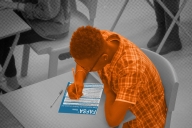You have /5 articles left.
Sign up for a free account or log in.
The American Council on Education on Wednesday released two reports from its Presidential Innovation Lab. The Bill & Melinda Gates Foundation-funded lab asks more than a dozen chief executives to think about how technological, pedagogical, organizational and structural innovations can close the student achievement gap.
The first paper, called "Unbundling Versus Designing Faculty Roles," traces the evolving role of the faculty, from mainly tutors in the 18 and 19th centuries, to the increasingly professionalized faculty of the early and mid-20th century, to contemporary professors, for whom teaching, research, service and others duties increasingly are “unbundled” or disaggregated. The paper argues that this unbundling is particularly acute in large introductory courses, where instructors mainly teach rather than design courses, and in massive, open, online courses, or MOOCs. At the same time, the paper says, unbundling is occurring in myriad ways, and “there is no single model.”
A common concern related to such unbundling, the paper says, is the potential for the decline of the “complete scholar,” whose research, teaching and service combine to positively impact students. But, the paper notes, community college teachers understandably may focus more on teaching than research. The paper also says that technology can help integrate teaching and research by making teaching more inquiry-driven, and by making teaching a kind of research process through student data analytics. The paper concludes that unbundling of professor duties is not necessarily bad for students, but that it requires further study. Colleges and universities may do well to study unbundling within their institutions and more intentionally assign faculty roles based on their evolving duties, as some institutions have done. But those conversations also should happen at the national level, the paper says.
The second paper, called "Beyond the Inflection Point: Reimagining Business Models for Higher Education," raises a broad range of questions about possible changes to higher education’s various business models. For example, the 10-page primer mentions the role of online education in potentially depressing tuition prices across the academy. It also looks at how competency-based education and prior-learning assessment could increase the acceptance of alternative credentialing in higher education. The context for these changes includes more scrutiny of costs in higher education and of the use of cross-subsidization among programs. While the paper doesn't provide firm answers to these challenges, it makes several suggestions, including a call for more collaboration between colleges and for institutions to consider outsourcing the teaching of introductory courses.









